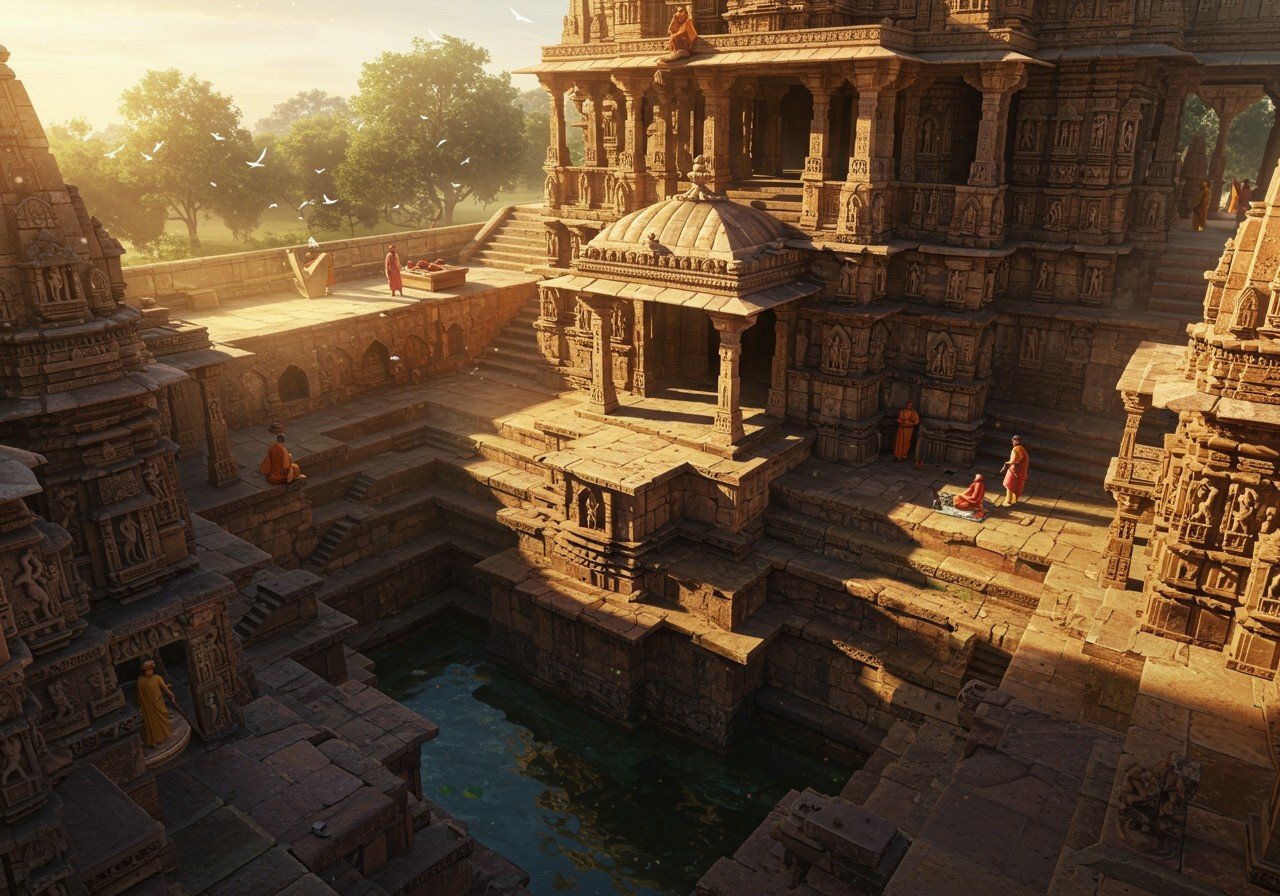
The Chaulukya Dynasty, also known as the Solanki Dynasty, was a prominent medieval Indian dynasty that reigned over parts of present-day Gujarat and Rajasthan from the 10th to the 13th centuries. Renowned for their significant contributions to art, architecture, and religious patronage, the Chaulukyas played a vital role in shaping the cultural and architectural landscape of medieval India, particularly North Indian temple architecture during the 11th to 13th centuries.
The Founding of the Chaulukya Dynasty
Establishing Rule and Expansion
Founded by Mularaja Solanki in 941 CE, the Chaulukya dynasty began with the overthrow of the last ruler of the Chapotkata dynasty. Taking their name from the Solanki clan of Rajputs, Mularaja’s reign ushered in an era of political stability and cultural flourishing in Gujarat. His successors, including Bhima I and Siddharaja Jayasimha, further expanded the kingdom and continued the patronage of art and architecture. The dynasty’s rule extended until the early 13th century when it was superseded by the Vaghela dynasty.
Magnificent Temples Built During the Chaulukya Reign
Exemplary Temple Architecture
The Chaulukya rulers were renowned patrons of temple architecture, commissioning some of India’s most exquisite temples, contributing significantly to the unique Vesara style, which combined elements of Nagara and Dravida styles. These architectural marvels stand as testaments to their devotion and artistic vision:
- Modhera Sun Temple: Built in the early 11th century by Bhima I, this temple is dedicated to the Sun God and showcases intricate carvings and a beautifully designed stepwell. Its unique architecture and intricate details make it a must-visit for those interested in the Chaulukya Dynasty’s architectural prowess.
- Rani ki Vav: This stunning stepwell, constructed during the reign of Bhima I’s queen, Udayamati, exemplifies the exceptional craftsmanship of the Chaulukya period. More than just a water source, it served as a social and religious gathering place, reflecting the dynasty’s commitment to community well-being.
- Somnath Temple: One of the twelve revered Jyotirlinga shrines, the Somnath Temple was rebuilt during Bhima I’s reign after its destruction by Mahmud of Ghazni. Its reconstruction signifies the Chaulukyas’ dedication to preserving religious sanctity and architectural heritage.
- Dilwara Temples: Situated at Mount Abu, these temples, constructed between the 11th and 13th centuries, are celebrated for their breathtaking marble work and intricate carvings. They represent a pinnacle of Chaulukya artistry and architectural finesse.
Influence on Art and Cultural Development
Patronage of Literature and Religion
The Chaulukya dynasty played a crucial role in the development of art and culture in medieval India:
- Literature: Chaulukya rulers extended their patronage to scholars like Hemachandra, a renowned Jain scholar and poet. This support fostered intellectual and literary growth during their reign.
- Architecture: Their patronage of intricately carved temples significantly influenced subsequent regional architectural styles, leaving a lasting impact on the architectural landscape of India. They built temples in the unique Vesara architecture, which combined elements of Nagara and Dravida styles. Notable examples of Chalukyan architecture include temples at Aihole, Pattakadal, and Badami, such as the Ladkhan temple, the Durga temple, and the Huchchimaltigudi shrine.
- Religious Patronage: The Chaulukyas supported both Jainism and Shaivism, leading to the construction of numerous Jain temples and Shaiva shrines, reflecting their religious tolerance and commitment to spiritual development.
- Stepwells: Elaborate stepwells like Rani ki Vav served not only as essential water sources but also as important venues for social and religious gatherings, highlighting the dynasty’s focus on community welfare.
How Poojn.in Helps Preserve Chaulukya Dynasty’s Religious Heritage
Poojn.in offers a wide selection of puja items that connect you to the rich religious traditions of the Chaulukya Dynasty era. Our curated collection includes:
- Authentic brass and copper items similar to those used in Chaulukya temples. These items are crafted with meticulous attention to detail, ensuring authenticity and quality.
- Traditional puja thalis that reflect medieval Gujarat’s artistic heritage. Our thalis are designed to enhance the spiritual experience of your puja rituals.
- Pure cotton wicks and ghee for temple-style ceremonies, allowing you to recreate the sacred atmosphere of Chaulukya temples in your home. These products are sourced with the utmost care to maintain their purity and quality.
- Handcrafted incense holders inspired by Chaulukya-era designs. These incense holders add a touch of historical elegance to your puja space.
- Specialized puja items for Kartikeya worship, including bronze Vel (spear) for home shrines, traditional oil lamps (diyas), sacred thread (yagnopavit), and pure copper water vessels. We offer a comprehensive range of items to facilitate your Kartikeya worship.
Explore our collection of brass murtis, pure cotton, and other puja essentials at poojn.in.
Conclusion
The Chaulukya Dynasty’s contributions to art, architecture, and religious patronage have left an enduring legacy on India’s history. Their magnificent temples, such as the Modhera Sun Temple and the Somnath Temple, stand as testaments to their architectural brilliance. The construction of stepwells like Rani ki Vav highlights their ingenuity and dedication to public welfare. By exploring their legacy, we gain a deeper appreciation for the rich history and traditions that have shaped India’s cultural identity. Their influence can be seen in later architectural styles and religious practices, reminding us of their significant contribution to India’s cultural tapestry.
Explore more about Indian temples and architecture on poojn.in through our informative blogs on Badami Cave Temples, Kandariya Mahadeva Temple, and Sas-Bahu Temples.


